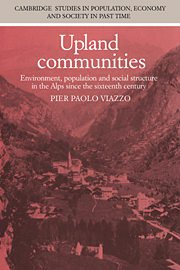 Upland Communities
Upland Communities Book contents
- Frontmatter
- Contents
- List of illustrations
- List of tables
- List of abbreviations
- Acknowledgements
- Introduction: anthropology, historical demography and the study of mountain societies
- 1 Environment, population and social structure: the Alpine village as an ecosystem
- 2 Open systems, open questions
- 3 Anthropologists in the Alps
- 4 The changing demography of Alpine communities
- 5 The traditional economy and its demise
- 6 The causes and consequences of Alpine emigration
- 7 The wealth from the earth: mining and immigration
- 8 Population, resources and homeostatic regulation
- 9 The domestic domain
- 10 Upland communities
- A summary of conclusions
- Bibliography
- Index
3 - Anthropologists in the Alps
Published online by Cambridge University Press: 13 October 2009
- Frontmatter
- Contents
- List of illustrations
- List of tables
- List of abbreviations
- Acknowledgements
- Introduction: anthropology, historical demography and the study of mountain societies
- 1 Environment, population and social structure: the Alpine village as an ecosystem
- 2 Open systems, open questions
- 3 Anthropologists in the Alps
- 4 The changing demography of Alpine communities
- 5 The traditional economy and its demise
- 6 The causes and consequences of Alpine emigration
- 7 The wealth from the earth: mining and immigration
- 8 Population, resources and homeostatic regulation
- 9 The domestic domain
- 10 Upland communities
- A summary of conclusions
- Bibliography
- Index
Summary
The Alps, ‘a magnificent laboratory’
Although Alpine anthropology has established itself only in the last few decades, it had a distinguished forerunner. In the summer of 1912 Robert Hertz, one of Durkheim's most gifted pupils, was spending his holidays in Cogne, a village in the Aosta Valley. His six-week vacation, however, soon turned into a short but industrious period of fieldwork when he became aware of the existence of an old religious tradition whose sociological features immediately intrigued him: the festival of Saint Besse, the patron saint of Cogne and of the adjacent Soana Valley, which took place every year on 8 August in a remote corner high in the mountains, at over 2,000 m of altitude. During the summer, Hertz was able to observe the pilgrimage to the saint's shrine and to attend the festival itself. In addition, he collected from the people of Cogne the local variants of the legends surrounding the saint, which shed revealing light on the web of social relationships that linked the various communities which congregated at the festival. Back in Paris, this material was supplemented by historical, philological and iconographic research. The resulting article, published in 1913, may well be seen as the first anthropological contribution to the study of the Alps.
This article clearly shows that Hertz regarded the Alps as an especially suitable terrain for the evolutionary study of society, and in particular of those ‘elementary forms of religious life’ which were at that time the central preoccupation of Durkheim and his school.
- Type
- Chapter
- Information
- Upland CommunitiesEnvironment, Population and Social Structure in the Alps since the Sixteenth Century, pp. 49 - 66Publisher: Cambridge University PressPrint publication year: 1989
